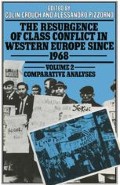Abstract
The growth of white-collar employment has been the most notable, and certainly the most often noted, feature of occupational change within late capitalism. For some two decades, non-manual employees have represented the largest single occupational category in the United States, and the general trend in Western Europe is clearly in this direction. Not suprisingly, the implications of this trend for the labour movement first attracted serious discussion in America: the decline in the traditional proletariat was widely regarded as a central cause of the stagnation and even decline in trade union membership after the late 1940s (e. g. Bell 1954). The premise of this analysis was often that non-manual workers did not possess, and could not be expected to acquire, the collectivist and/or anti-capitalist sentiments seen as the necessary inspiration of a viable labour movement. On occasion this line of argument has been developed to grandiose proportions as an explicit antithesis to the Marxian conception of the historic role of the working class. Thus Bell comments (1974:125–6) that
in the utopian visions of Marx and the socialist movement, the working class, made conscious of its fate by the conditions of struggle, was seen as the agency not only of industrial but of human emancipation. … Yet if one takes the industrial worker as the instrument of the future, or, more specifically, the factory worker as the symbol of the proletariat, then this vision is warped. For the paradoxical fact is that as one goes along the trajectory of industrialization — the increasing replacement of men by machines — one comes logically to the erosion of the industrial worker himself. In fact, by the end of the century the proportion of factory workers in the labor force may be as small as the proportion of farmers today. … Instead of the industrial worker, we see the dominance of the professional and technical class in the labor force — so much so that by 1980 it will be the second largest occupational group in the society, and by the end of the century the largest.
Access this chapter
Tax calculation will be finalised at checkout
Purchases are for personal use only
Preview
Unable to display preview. Download preview PDF.
Editor information
Editors and Affiliations
Copyright information
© 1978 Palgrave Macmillan, a division of Macmillan Publishers Limited
About this chapter
Cite this chapter
Hyman, R. (1978). Occupational Structure, Collective Organisation and Industrial Militancy. In: Crouch, C., Pizzorno, A. (eds) The Resurgence of Class Conflict in Western Europe since 1968. Palgrave Macmillan, London. https://doi.org/10.1007/978-1-349-03025-5_2
Download citation
DOI: https://doi.org/10.1007/978-1-349-03025-5_2
Publisher Name: Palgrave Macmillan, London
Print ISBN: 978-1-349-03027-9
Online ISBN: 978-1-349-03025-5
eBook Packages: Palgrave Business & Management CollectionBusiness and Management (R0)

